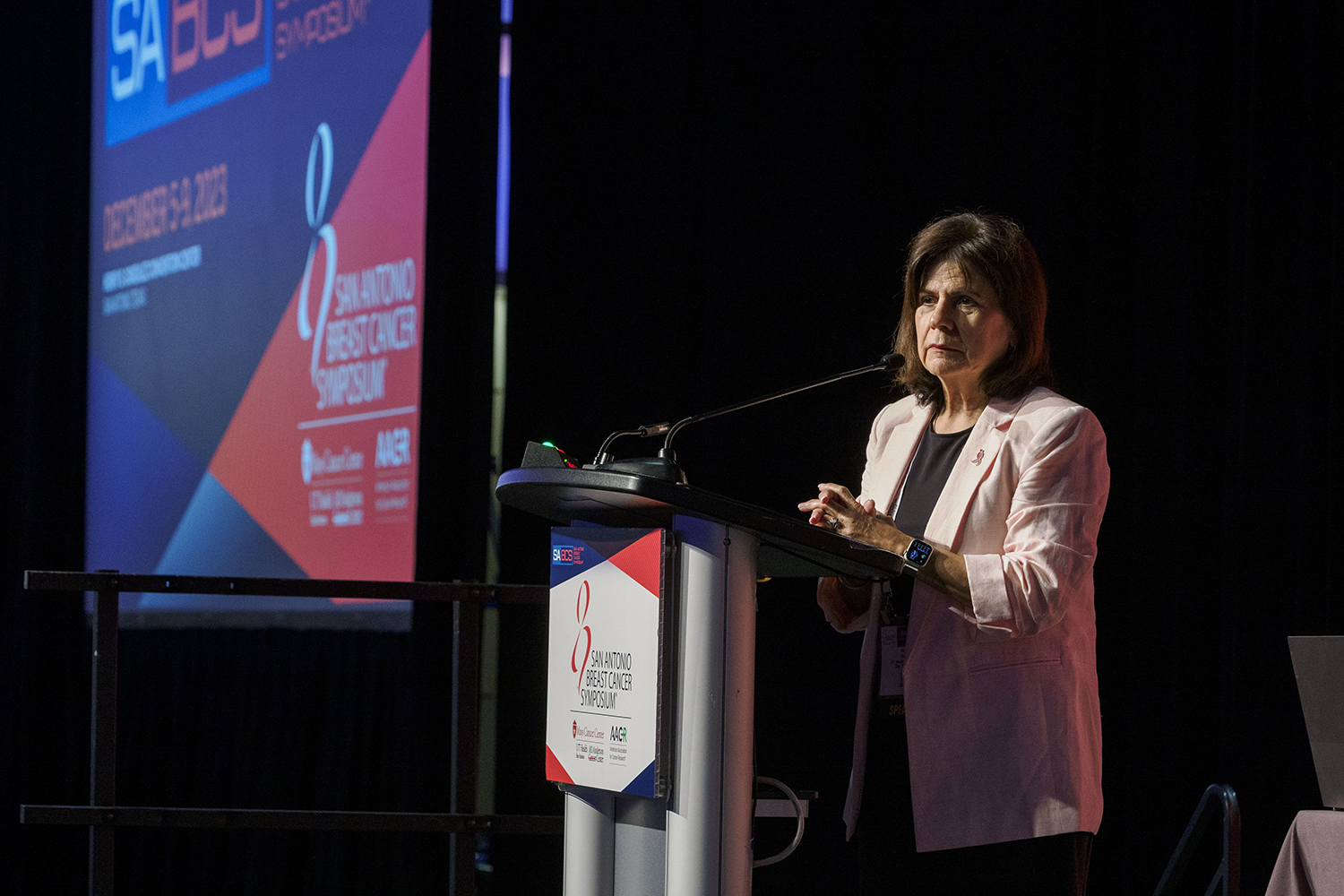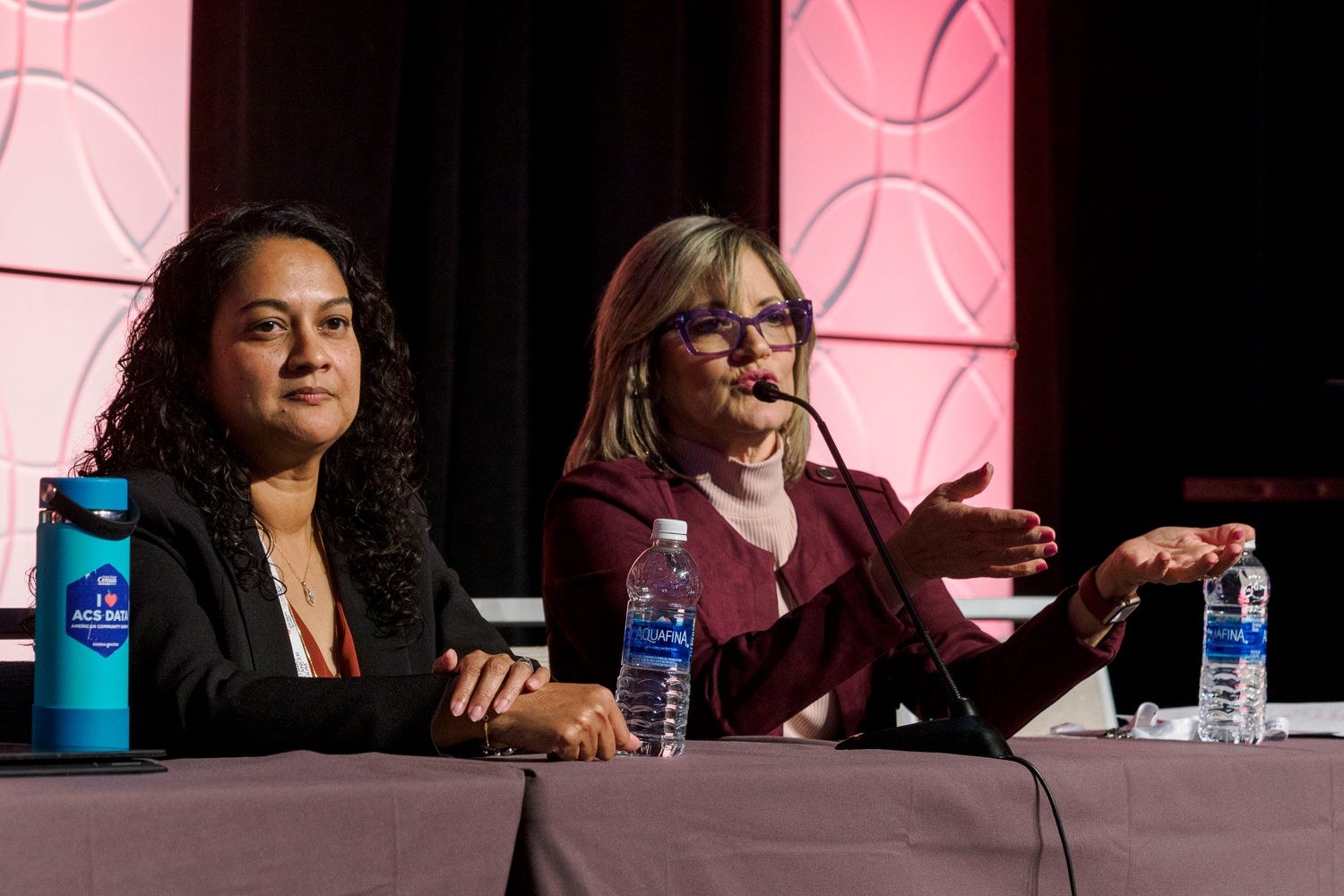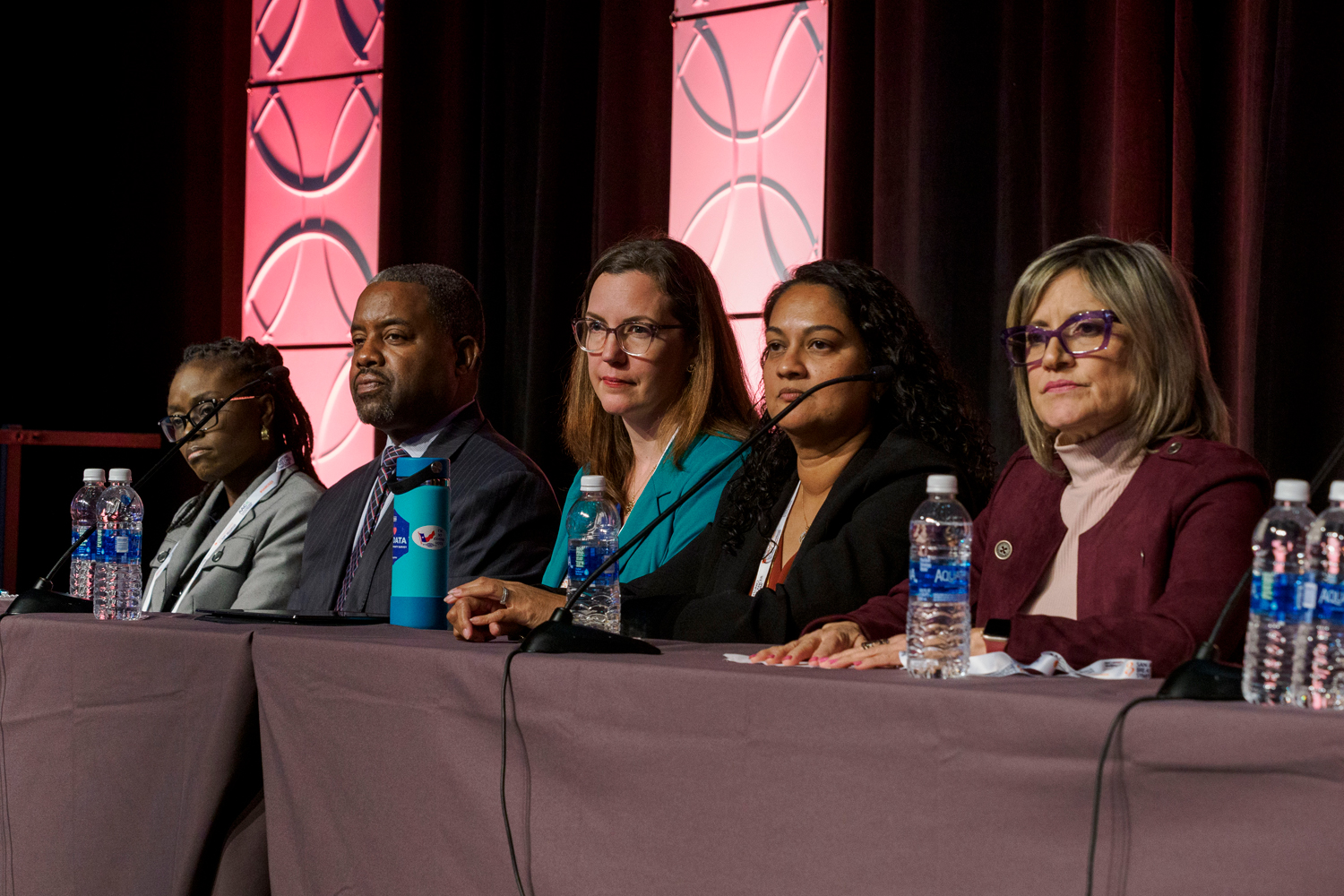SOCIAL DETERMINANTS OF HEALTH—nonmedical factors such as where people live and work—play a vital role in health care and disease outcomes, said health equity researcher Amelie Ramirez, director of the Institute for Health Promotion Research at UT Health San Antonio.
Ramirez spoke at and moderated a Dec. 5 panel at the San Antonio Breast Cancer Symposium (SABCS) discussing social determinants and what can be done to address the impacts they have on health.
“In many cases now, people are wondering if your ZIP code is almost as important as your genetic code,” Ramirez said, “because where you live, work and play truly can impact your health.”
Inequities in these areas can lead to social needs that harm people’s health, according to Ramirez. These include financial stress, lack of reliable transportation, unstable or unaffordable housing, and inadequate job benefits like paid time off and health insurance.

Amelie Ramirez moderates a discussion on social determinants of health at SABCS. Photo Courtesy © SABCS/Todd Buchanan
Social needs are more commonly experienced by Black and Hispanic people compared with white and Asian populations, Ramirez said. For example, in 2018, 11% of nonelderly Black people and 19% of nonelderly Hispanic people in the U.S. lacked affordable health insurance, compared with 8% of the white and 7% of the Asian populations. Health problems resulting from disparities include obesity, asthma, diabetes and heart disease, she said.
Health care systems are placing more emphasis on screening patients for social determinants of health, Ramirez said, but there are “no standardized screening tools that are used right now so that we can make comparisons in different areas.”
Social risks have a large impact on cancer patients, said health equity researcher Brenda Adjei, associate director of the office of healthcare delivery and equity research at the National Cancer Institute.
“We know that cancer patients are likely to experience social risks and social needs,” said Adjei. These risks—including food insecurity, housing instability and transportation barriers—can lead to patients receiving care that does not adhere to standard treatment guidelines, patients not starting or completing treatment, delays and interruptions in treatment, lower quality of life, and late-stage cancer diagnoses and lower survival.
Research has shown that barriers to reducing social risks exist at different levels, Adjei said, from clinicians and their staff members to health care institutions and the larger community. “These barriers cut across all levels,” she said, adding that interventions to address them similarly need to cut across all levels.
Brian Rivers, director of the Cancer Health Equity Institute of Morehouse School of Medicine in Atlanta, described the AACR Cancer Disparities Progress Report as a “report card” on the progress made against disparities. (The American Association for Cancer Research [AACR] publishes Cancer Today.) The report explains disparities caused by many factors, including environmental, behavioral, social, clinical, cultural, psychological, and biological and genetic factors, Rivers said.
“Anybody who wants to intervene on any of these disparate outcomes cannot address only one of these factors, but must address multiple factors,” he said.
Rivers described downstream and upstream factors that contribute to disparities, starting with an individual’s biology, risk behaviors and demographic status, running through a person’s relationships with others, and upstream to social institutions and society at large.
According to Rivers, who cited data from the Department of Health and Human Services, only “about 20% of health outcomes can really be attributed to clinical care, while social determinants of health can contribute to up to 50% of the county-level variation we see in health outcomes.”
Rivers cited Grady Cancer Center in Atlanta as a health care institution that is addressing social needs among its patients, including food insecurity, homelessness, lack of transportation and financial toxicity. Grady has sought funding and built partnerships with area businesses, educational institutions, and community and advocacy organizations. They also set up screening and deployed dietitians, nurse navigators and other health professionals to meet patients’ needs, he said.
Sandi Pruitt, a health care researcher at UT Southwestern Medical Center in Dallas, focused her talk on lack of food because it’s “a solvable social need.” As an example, she described how food insecurity increased at the start of the COVID-19 pandemic. Yet, despite disruption caused by the pandemic, the prevalence of food insecurity in the U.S. remained stable at 10.5% in 2019 and 2020, the year the pandemic began in the U.S., because “we had political will to deploy an existing set of programs,” including federal food programs like the Supplemental Nutrition Assistance Program (SNAP). Unfortunately, over the past year in Texas, Pruitt said, SNAP benefits have been stopped and work requirements implemented that have reduced the number of people benefiting from the program and increased the number of Texans without enough to eat.
Harold C. Simmons Comprehensive Cancer Center at UT Southwestern in Dallas has made food insecurity a focus, Pruitt said. She described steps the cancer center has taken to address the issue, including setting up appointments for people to pick up free food, rather than waiting in long lines, and establishing more food distribution centers in the community.

Susan T. Vadaparampil and Bárbara Segarra-Vázquez participate in the panel discussion of social determinants of health at SABCS. Photo Courtesy © SABCS/Todd Buchanan
Susan T. Vadaparampil, associate center director of community outreach, engagement, and equity at Moffitt Cancer Center in Tampa, Florida, described how measures to address social needs were implemented and evaluated at Moffitt.
Since 2006, she said, Moffitt included social needs assessments as part of a questionnaire for incoming patients. Among the issues identified in the questionnaires were transportation difficulties, financial problems and childcare issues.
Vadaparampil described measures taken by Moffitt, including building partnerships with health care providers, community organizations, government and others, because “we have part of the answer but, without partners, we don’t have the entire answer.”
The final speaker, researcher Bárbara Segarra-Vázquez of the School of Health Professions of the University of Puerto Rico in San Juan and a cancer survivor, described how patients might not feel comfortable answering screening questionnaires accurately. People might feel they could be discriminated against for being honest, she said, or singled out or targeted by having to fill out the questionnaire.
“If I say I have a financial problem, they might not give me the treatment that costs more or that I deserve, so they are really afraid of revealing what is going on with them,” she said.
Segarra-Vázquez also raised the issue of providing health care information for Spanish-speaking people. Twenty percent of people living in the U.S. are Hispanic, she said, and 70% of those people don’t speak English at home, “so we have a language problem.”
Cancer Today magazine is free to cancer patients, survivors and caregivers who live in the U.S. Subscribe here to receive four issues per year.





